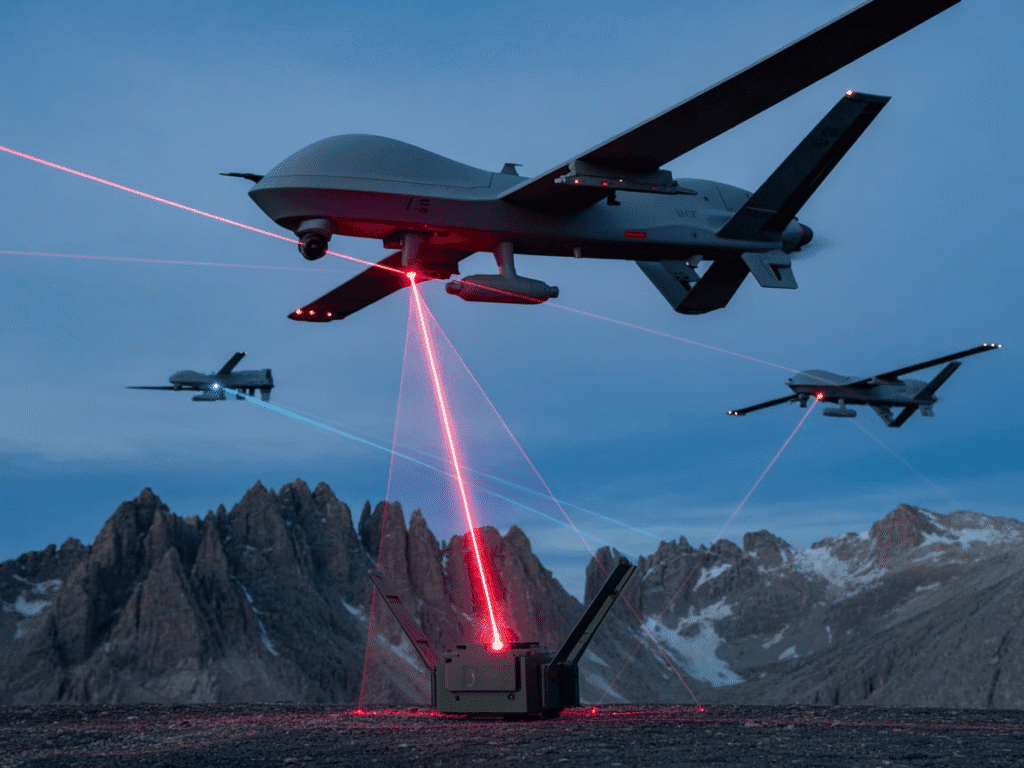✈️ What is the POWER Program?
DARPA’s POWER (Persistent Optical Wireless Energy Relay) initiative aims to create a wireless energy web using lasers and high-altitude relay nodes. The goal: beam power from ground sources up to airborne optical relays, which then redirect energy through multiple hops to final ground receivers—potentially hundreds of kilometers away.

Key Innovations & Milestones
1. Phase 1: Relay Design
- In September 2023, DARPA awarded contracts to RTX (Raytheon), Draper Laboratory, and BEAM Co. to design modular optical relay systems.
- These relays must reflect and redirect high-quality laser beams with wavefront correction, while harvesting enough energy to power their own airborne platforms.
2. PRAD Record-Setting Demonstration
- In May 2025, the POWER Receiver Array Demo (PRAD) achieved a breakthrough: 800 W delivered over 8.6 km (5.3 mi) in just 30 seconds—completely smashing the old record of 230 W at 1.7 km.
- Over the campaign, more than 1 megajoule of energy was transferred.
3. Receiver Technology
- Teravec Technologies (with Packet Digital and RIT) built a compact-aperture receiver featuring:
- A parabolic mirror directing light onto arrays of photovoltaic cells,
- Over 20% efficiency (laser-to-electric) at shorter ranges
- The receiver is scalable and can integrate into UAVs or manned aircraft
4. Technical Significance
- PRAD tests were conducted ground-to-ground—through the densest atmospheric layers—making the results even more significant.
- Demonstrations disproved previous limits on range and power, showing the feasibility of airborne relay networks .
🚀 What’s Next: Phase 2 & Beyond
- Integrated Airborne Relay Trials
Phase 2 will embed relays into pods on aircraft/UAVs. Plans include testing vertical links at White Sands to deliver ~10 kW of laser power across 125–200 miles, via three airborne nodes - Wavefront & Beam Control
Relays will feature adaptive optics to re-focus laser beams mid-flight and harvest some of the beam for on-board power. - Optimized Platform Design
Removing on-board fuel/generation lets future aircraft become lightweight, persistent platforms with near-unlimited range and endurance. - Industry Participation
DARPA hosted an Industry Day on May 29, 2025, seeking teams for Phase 2. Offers due by end of July 2025 .
Why POWER Matters
- Battlefield Resilience: Beaming power at the speed of light removes fuel lines, vulnerable convoys, and logistical delays.
- Platform Freedom: Drones and aircraft could operate indefinitely, powered wirelessly—ready for long-duration missions.
- Commercial & Space Applications: The same tech could enable satellite solar-to-Earth power, remote disaster relief, or off-grid communities.
🌐 Innovations Summary Table
| Feature | Achievement |
|---|---|
| Range & Power | 800 W at 8.6 km (5.3 mi) – new record |
| Receiver Design | Compact aperture → parabolic mirror → PV cells; >20% efficiency |
| Relay Platforms | Modular pods with beam steering & power harvesting |
| Demonstrated Potential | Ground-to-ground through dense atmosphere 🌫 and three-hop airborne architecture envisioned |
In Summary
DARPA’s POWER program is transforming the concept of logistics and energy distribution by creating a resilient, airborne laser power web. With record-breaking PRAD results and ambitious plans for airborne relays, the initiative is rapidly moving toward real-world demonstration of multi-hop, long-range laser power transmission—unlocking operational freedom, endurance, and flexibility for future platforms.
🔭 Discussion Questions
- What engineering hurdles remain for multi-hop airborne laser networks?
- How might adversaries attempt to disrupt or spoof these energy beams?
- Could this tech cross over into commercial sectors like off-grid communities or renewable energy storage?
How do you see POWER reshaping military strategy—or even civilian life—in the coming decade?


This is my first time pay a quick visit at here and i am really happy to read everthing at one place